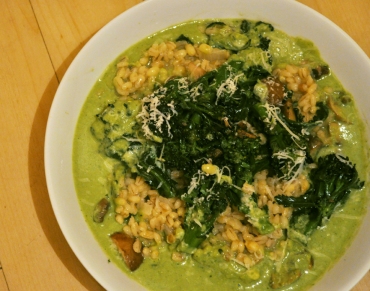
Do you ever start to make a recipe and then realise you’re missing a vital ingredient? Only the other day I was busy assembling a meal of (Turkish vegetable casserole) Turlu Turlu when I remembered I had no tomatoes in the house in any shape or form. Which reminds me that ETP should feature that recipe at some point.
Well, this risotto recipe may look complete, but secreted within it is a similar story. It was meant to include elements of fennel (in the oil) and broad beans (adding colour and texture to the risotto). Oh dear. I can feel our old friend Denis Cotter, whose recipe we were stealing, shaking his head admonishingly.
But we persevered and, if you haven’t tried a beetroot risotto before, so should you. Here’s how:
The lemon oil was made by shaking olive oil with the zest and juice of a lemon in a jar. Easy – in effect a basic lemony dressing.
Beets are then boiled/simmered until tender (anywhere between 20-40 minutes, depending on size), drained, rinsed under cold water then peeled. They are then diced and roasted with a little olive oil and salt for 15 minutes. Don’t burn them – it’s easily done.
After 15 minutes, remove half the beets and, adding about a cup-full of vegetable stock or water, blend to a puree in a food processor and put it in a pan on the hob, adding enough extra stock to make the amount of risotto you’re cooking. Keep the stock hot. Continue to cook the remainder of the beets in the oven for 10 more minutes or so, until they begin to caramelise.
Now for the rice – and this really just becomes a standard risotto cooking method with a different type of stock. So, saute a couple of finely sliced shallots and 2 cloves of garlic in a little olive oil for 5 minutes. Add arborio risotto rice and ‘toast’ it in the pan for 5 minutes, stirring often. Add a small glass or red wine and cook for a further 5 minutes or so to ‘burn off’ the alcohol. Then start to add the beetroot stock, a ladle at a time. Keep going until the risotto is just tender. It should be pink too! When it’s done, stir in the caramelised beets and a little butter.
To serve, plate up the rice, scatter over some goats cheese and drizzle the lemon oil over.
Even if it wasn’t the recipe we had initially intended, it still worked – big flavours all round, from sweet beets to tangy goats cheese to perfumed lemon.
The prize goes to the best colour pink, along with the biggest flavours. The photo here doesn’t quite do ours justice – but I think another bash at the recipe could improve it. A magenta risotto, anyone?






Recipes for nettles
This is perhaps a point at which foraging for food becomes a prickly subject. All those features and TV cookery programmes that see chefs scouring wild landscapes for sea buckthorn or roaming the woods to find edible funghi… all that foraged food can seem ever so exotic, fit for a restaurant such as Noma in Copenhagen or one of its many followers. And yet, there’s a much more common ingredient, which grows in abundance, and which is probably due a revival, and which great so many kinds of recipes. It is, of course, the humble nettle. Why aren’t we all out there picking them?
Down the trail near our house nettles are shooting up all over the place at the moment: their fresh young leaves so green – not like the old deep green and tough-looking leaves found later in the year. But it’s not just about being in the countryside – I used to see nettles peeking through railings and rising up at the edges of the parks and canals of urban East London.
I’ve never picked any, though. Have you? Is it just me that’s been missing out? I had a lovely bowl of nettle soup once, at Petersham Nurseries. It was something of a revelation in its delicate greenness. And then it was forgotten again.
But when this damn rain stops I’m going to head out with some thick gloves and pick some nettles. And I’m going to make something with them. Watch this space.
In the meantime, here are a few ideas that might convince you to do the same.
For those of you who might want to make your own fresh pasta, try Blanche Vaughan’s nettle ravioli here. The Guardian feature is worth a read in any case, to put your mind at rest about how to treat nettles and their avoid their stings.
More recently in the Guardian is Hugh FW and his recipes for a nettle soup, a risotto and a nettle and feta filo pie. They’re here.
Happy foraging. Let us know how it goes!
Posted in Chefs, Comment, Feta, Greece, Greens, Nettles, Pasta, Pastry, Rice, Soups, Veg in season | Leave a Comment »